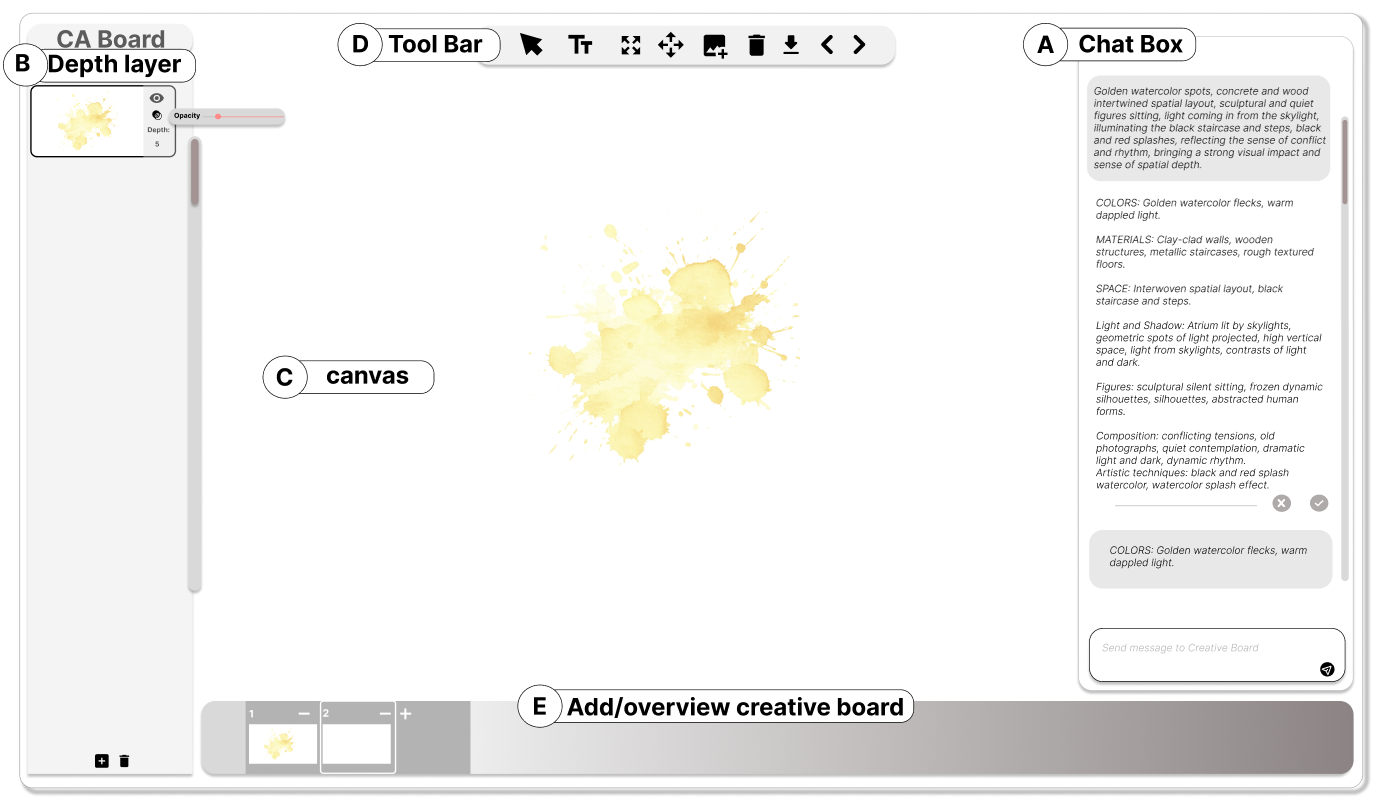Publications
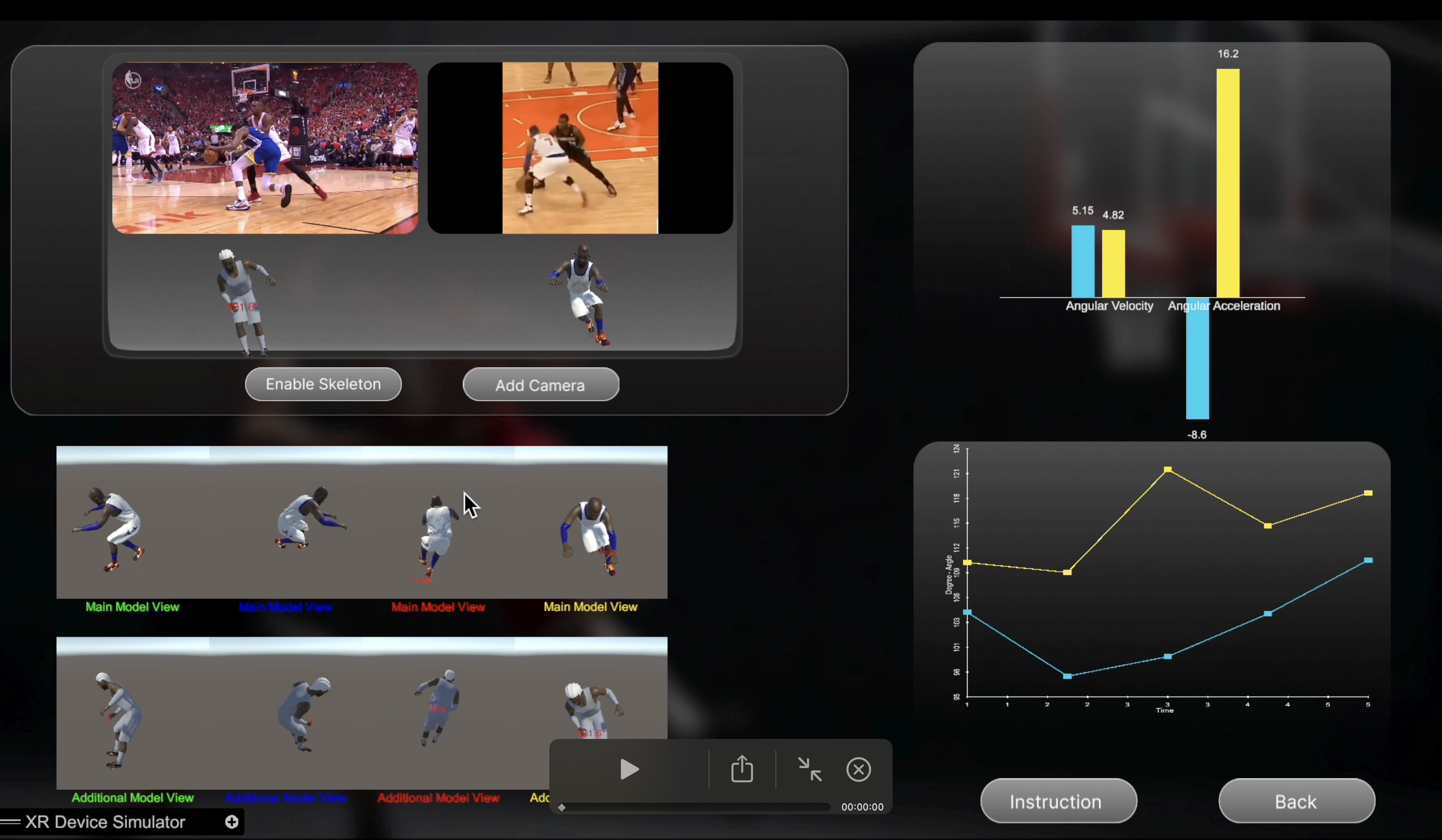
BioFeed: A Visual Analytics System for Injury Risk Detection in Sports
ACM CHI 2026OngoingUt Gong, Chunggi Lee, Tica Lin, Hanspeter Pfister
Injury prevention in sports requires timely identification of risky motions, yet biomechanics experts often lack tools to analyze movements effectively during practice or games. We developed BioFeed, a visual analytics system that integrates a pipeline of computer vision-based motion detection, biomechanical feature extraction (using OpenSim), and injury risk identification via expert-informed thresholds. The system supports an immersive 3D user interfaces, enabling detailed exploration of joint angles, forces, and movement patterns. A formative study with biomechanics experts highlighted its value in improving injury awareness and informed decision-making during training.

BioFeed: A Visual Analytics System for Injury Risk Detection in Sports
ACM CHI 2026OngoingUt Gong, Chunggi Lee, Tica Lin, Hanspeter Pfister
Injury prevention in sports requires timely identification of risky motions, yet biomechanics experts often lack tools to analyze movements effectively during practice or games. We developed BioFeed, a visual analytics system that integrates a pipeline of computer vision-based motion detection, biomechanical feature extraction (using OpenSim), and injury risk identification via expert-informed thresholds. The system supports an immersive 3D user interfaces, enabling detailed exploration of joint angles, forces, and movement patterns. A formative study with biomechanics experts highlighted its value in improving injury awareness and informed decision-making during training.
My Role: Conception, Formative Study, Pipeline Development, UI Design, Evaluation, Paper Writing
CABoard: An AI-Driven Collage System for Creative Ideation and Narrative Communication
CHI 2026Under ReviewWeichen Sun, Junxiu Tang, Ut Gong, Yingcai Wu, Tan Tang
Creative ideation often relies on visual mood boards and collages, but these tools remain time-consuming and lack narrative clarity. We developed CABoard, an intelligent design platform powered by a multi-agent system and large language models (LLMs) to streamline collage creation and enhance storytelling in creative workflows. CABoard introduces a 2.5D progressive narrative structure and a Designer-in-the-Loop mechanism, enabling users to generate, organize, and refine visual elements interactively. A formative study with 27 designers identified key bottlenecks in current workflows, informing the design of CABoard’s components: Task Expansion Engine, Image Generator, Key Element Extractor, Layout Manager, and Narrative Organizer. The system accelerates design iterations, supports clear communication of creative intent, and adapts across diverse domains such as product design, filmmaking, and branding.
CABoard: An AI-Driven Collage System for Creative Ideation and Narrative Communication
CHI 2026Under ReviewWeichen Sun, Junxiu Tang, Ut Gong, Yingcai Wu, Tan Tang
Creative ideation often relies on visual mood boards and collages, but these tools remain time-consuming and lack narrative clarity. We developed CABoard, an intelligent design platform powered by a multi-agent system and large language models (LLMs) to streamline collage creation and enhance storytelling in creative workflows. CABoard introduces a 2.5D progressive narrative structure and a Designer-in-the-Loop mechanism, enabling users to generate, organize, and refine visual elements interactively. A formative study with 27 designers identified key bottlenecks in current workflows, informing the design of CABoard’s components: Task Expansion Engine, Image Generator, Key Element Extractor, Layout Manager, and Narrative Organizer. The system accelerates design iterations, supports clear communication of creative intent, and adapts across diverse domains such as product design, filmmaking, and branding.
My Role: Conception, Formative Study, System Design, Agent Implementation, Paper Writing
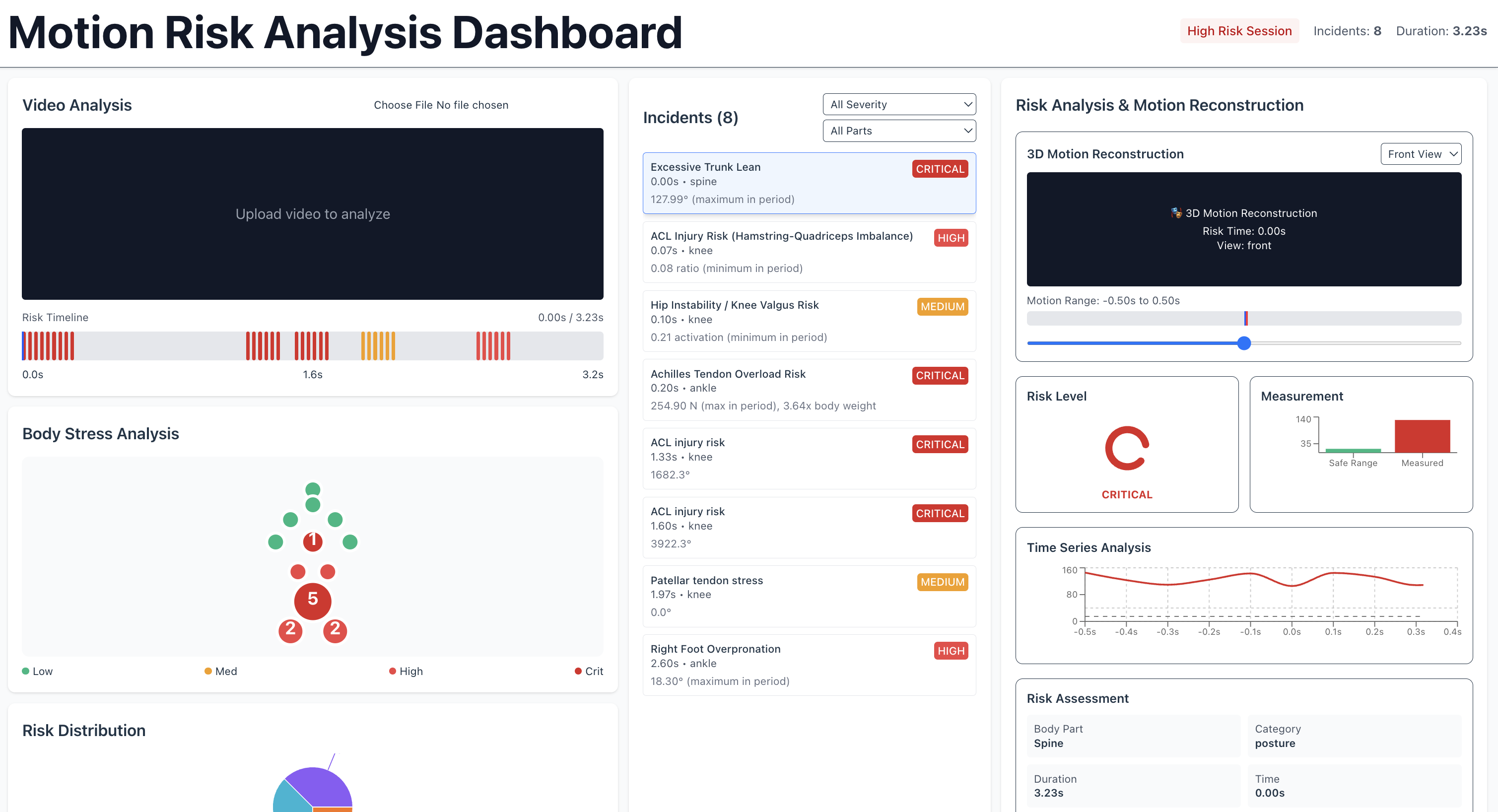
Visual Analytics for Injury Risk Exploration in Sports
16th workshop on Visual Analytics in Healthcare in VIS 2025Under ReviewChunggi Lee, Ut Gong, Tica Lin, Hanspeter Pfister
Injury prevention in sports requires understanding biomechanical risks in context. We present a visual analytics system that combines 3D joint reconstruction (via SMPL) and biomechanical risk estimation (via OpenSim), structured by the Haddon Matrix. The system maps features like joint torque and injury risk across pre-, during-, and post-event phases, enabling users to explore injury mechanisms and intervention points. A synchronized interface with 3D playback, force plots, and risk timelines supports dynamic analysis. This approach integrates structured analysis and visualization to inform data-driven prevention and enhance athlete safety.

Visual Analytics for Injury Risk Exploration in Sports
16th workshop on Visual Analytics in Healthcare in VIS 2025Under ReviewChunggi Lee, Ut Gong, Tica Lin, Hanspeter Pfister
Injury prevention in sports requires understanding biomechanical risks in context. We present a visual analytics system that combines 3D joint reconstruction (via SMPL) and biomechanical risk estimation (via OpenSim), structured by the Haddon Matrix. The system maps features like joint torque and injury risk across pre-, during-, and post-event phases, enabling users to explore injury mechanisms and intervention points. A synchronized interface with 3D playback, force plots, and risk timelines supports dynamic analysis. This approach integrates structured analysis and visualization to inform data-driven prevention and enhance athlete safety.
My Role: Conception, Implementation, Evaluation, Paper Writing
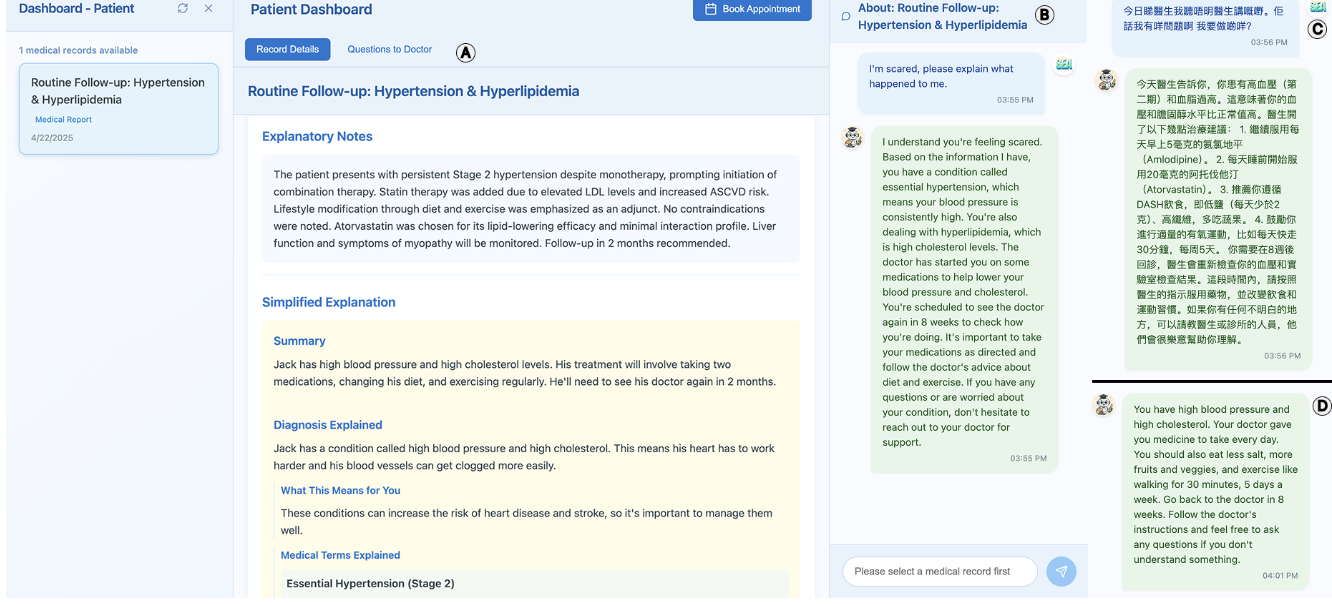
CLEAR: A Bidirectional Framework for Enhancing Doctor-Patient Communication in Resource-Constrained Healthcare Settings
CSCW 2026Under ReviewUt Gong, Yibo Meng, Haiyang Xu, Xin Chen, Chunggi Lee, Hanspeter Pfister, Yan Guan
Effective doctor–patient communication is essential but often hindered by resource constraints. We created CLEAR (Contextual Learning and Explanation Agent for Results), a bidirectional framework built on domain‐specialized LLMs and the ReAct methodology to improve medical communication in low‐resource settings. A formative study with 28 participants across China and Macau revealed key barriers, guiding the design of six components: Patient Profile Manager, Clinical Input Processor, Explanation Generator, Question Evaluator, Multimodal Output Adapter, and Report Generator. We implemented MediCLEAR and evaluated it with 20 patients and 8 providers, achieving 98 % explanation accuracy, a 50–60 % reduction in consultation time, improved patient comprehension and recall, and high user satisfaction—especially in underserved regions.

CLEAR: A Bidirectional Framework for Enhancing Doctor-Patient Communication in Resource-Constrained Healthcare Settings
CSCW 2026Under ReviewUt Gong, Yibo Meng, Haiyang Xu, Xin Chen, Chunggi Lee, Hanspeter Pfister, Yan Guan
Effective doctor–patient communication is essential but often hindered by resource constraints. We created CLEAR (Contextual Learning and Explanation Agent for Results), a bidirectional framework built on domain‐specialized LLMs and the ReAct methodology to improve medical communication in low‐resource settings. A formative study with 28 participants across China and Macau revealed key barriers, guiding the design of six components: Patient Profile Manager, Clinical Input Processor, Explanation Generator, Question Evaluator, Multimodal Output Adapter, and Report Generator. We implemented MediCLEAR and evaluated it with 20 patients and 8 providers, achieving 98 % explanation accuracy, a 50–60 % reduction in consultation time, improved patient comprehension and recall, and high user satisfaction—especially in underserved regions.
My Role: Conception, Formative Study, Implementation, Evaluation, Paper Writing
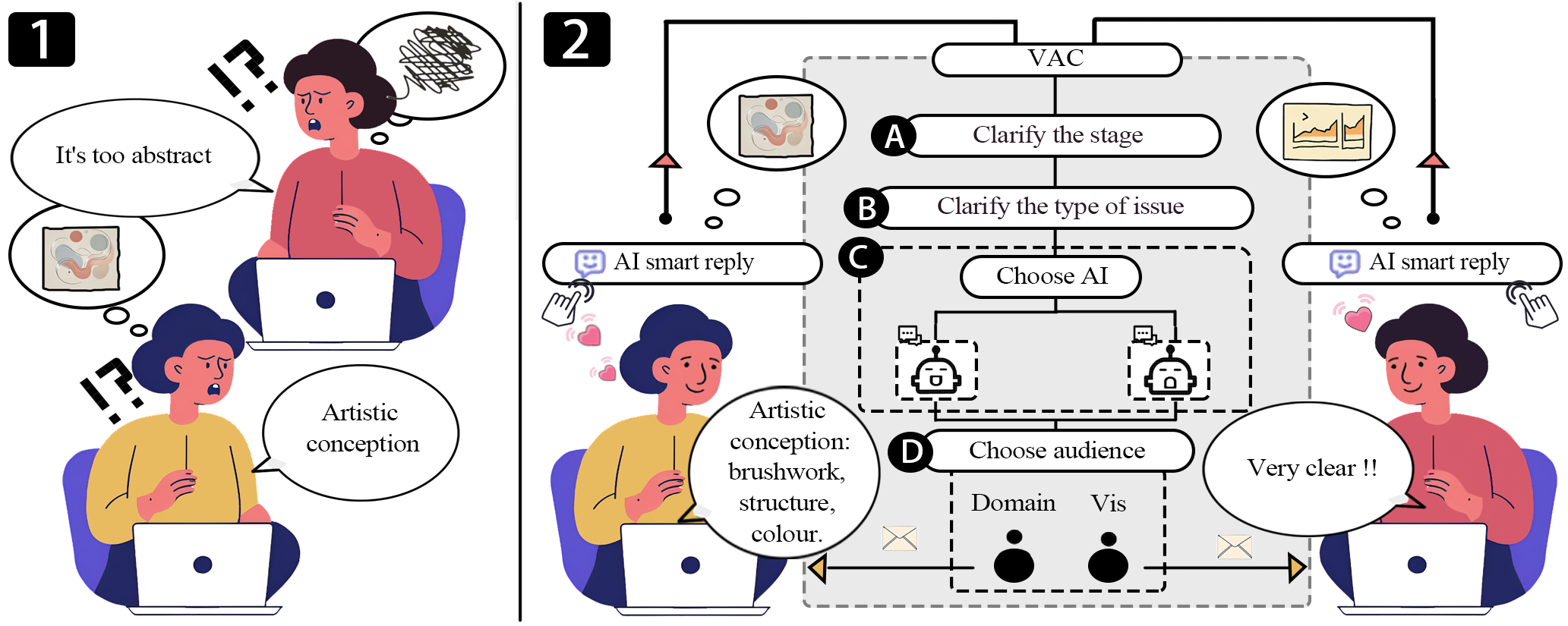
Perhaps We Cannot Continue Collaborating: Understanding and Alleviating Asymmetry in Communication for Visual Analytics Collaboration
CSCW 2025Under ReviewWeichen Sun, Junxiu Tang, Linping Yuan, Feiyuan Qu, Junming Gao, Ut Gong, Xiaojiao Chen, Tan Tang
This paper builds on prior CSCW about care work by addressing communication asymmetries specific to visual analytics (VA) collaborations, such as differences in cognitive understanding and resource access, that traditional collaborative design study frameworks overlook. It proposes an AI-assisted smart reply system, VisAuto-Communication (VAC), which significantly improves communication efficiency and positive engagement by structuring exchanges based on identified asymmetry types. The results are useful for designing computing technologies that adapt responses to asymmetric communication inherent in collaboration, fostering clearer and more productive interactions in collaborative settings.

Perhaps We Cannot Continue Collaborating: Understanding and Alleviating Asymmetry in Communication for Visual Analytics Collaboration
CSCW 2025Under ReviewWeichen Sun, Junxiu Tang, Linping Yuan, Feiyuan Qu, Junming Gao, Ut Gong, Xiaojiao Chen, Tan Tang
This paper builds on prior CSCW about care work by addressing communication asymmetries specific to visual analytics (VA) collaborations, such as differences in cognitive understanding and resource access, that traditional collaborative design study frameworks overlook. It proposes an AI-assisted smart reply system, VisAuto-Communication (VAC), which significantly improves communication efficiency and positive engagement by structuring exchanges based on identified asymmetry types. The results are useful for designing computing technologies that adapt responses to asymmetric communication inherent in collaboration, fostering clearer and more productive interactions in collaborative settings.
My Role: Conception, Paper Writing
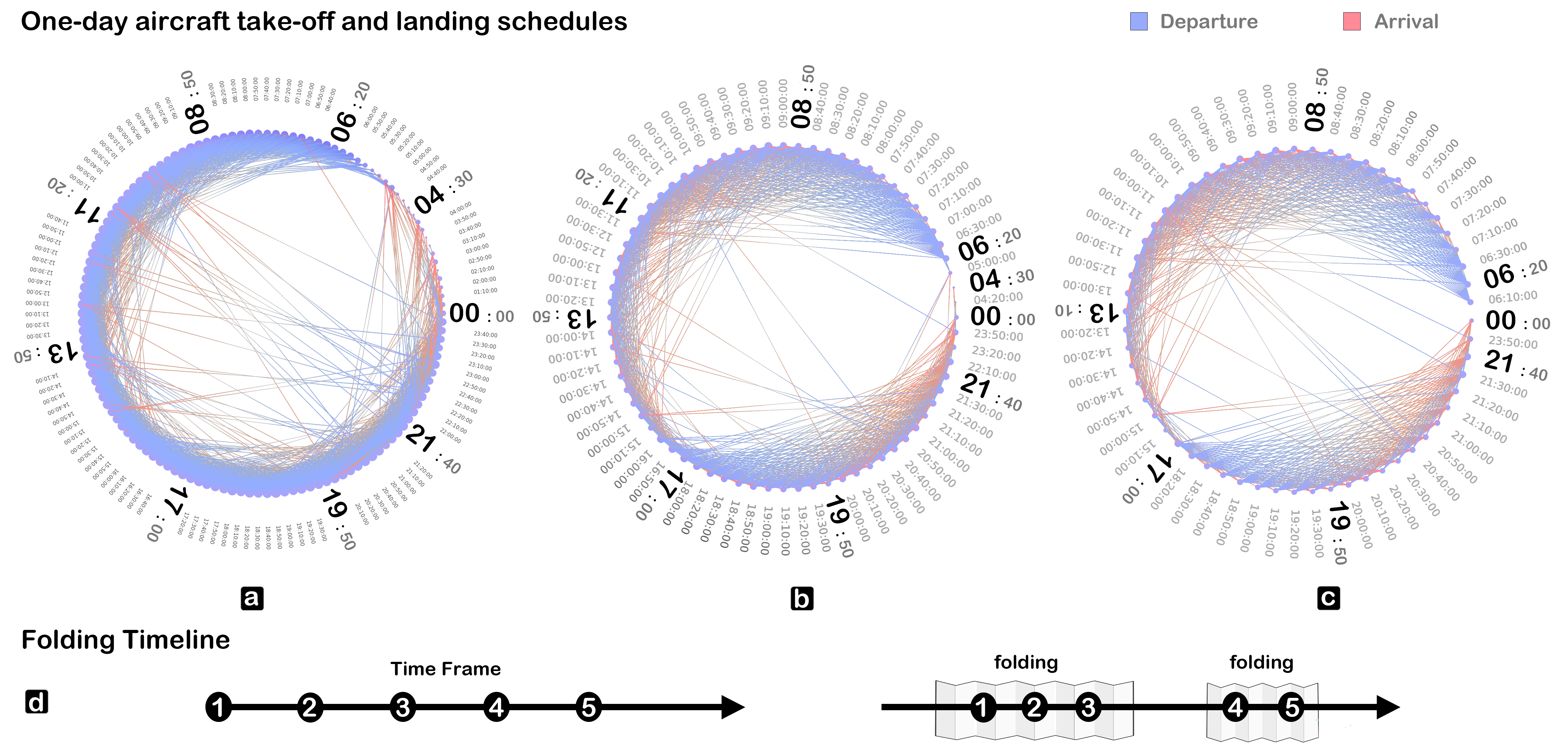
TimeFolder: A Universal Framework for Enhancing Visualization Across Time-Oriented Data Methods
ChinaVIS 2025AcceptedUt Gong, Weichen Sun, Shuhan Liu, Yang Liu, Tan Tang, Yingcai Wu
Visualizing ultra-long time-oriented data often leads to over-plotting and obscures important patterns. Traditional compression methods can miss critical details and are often unsuitable for various visualization techniques. We introduce TimeFolder, a versatile framework that balances data compression and visual information preservation using the Minimum Description Length (MDL) principle. TimeFolder adaptively folds timelines, highlighting significant data elements and incorporating visual channels for accurate representations. Our heuristic algorithm employs hierarchical clustering and random seeds to explore optimal compression configurations efficiently. Supporting diverse visualization techniques, TimeFolder offers customizable solutions for different contexts. Demonstrated through real-world use cases like exchange rate analysis and airport scheduling, TimeFolder effectively transforms extensive temporal datasets into concise, analytically rich visual summaries, enhancing temporal data visualization across various applications.

TimeFolder: A Universal Framework for Enhancing Visualization Across Time-Oriented Data Methods
ChinaVIS 2025AcceptedUt Gong, Weichen Sun, Shuhan Liu, Yang Liu, Tan Tang, Yingcai Wu
Visualizing ultra-long time-oriented data often leads to over-plotting and obscures important patterns. Traditional compression methods can miss critical details and are often unsuitable for various visualization techniques. We introduce TimeFolder, a versatile framework that balances data compression and visual information preservation using the Minimum Description Length (MDL) principle. TimeFolder adaptively folds timelines, highlighting significant data elements and incorporating visual channels for accurate representations. Our heuristic algorithm employs hierarchical clustering and random seeds to explore optimal compression configurations efficiently. Supporting diverse visualization techniques, TimeFolder offers customizable solutions for different contexts. Demonstrated through real-world use cases like exchange rate analysis and airport scheduling, TimeFolder effectively transforms extensive temporal datasets into concise, analytically rich visual summaries, enhancing temporal data visualization across various applications.
My Role: Conception, Implementation, Evaluation, Paper Writing
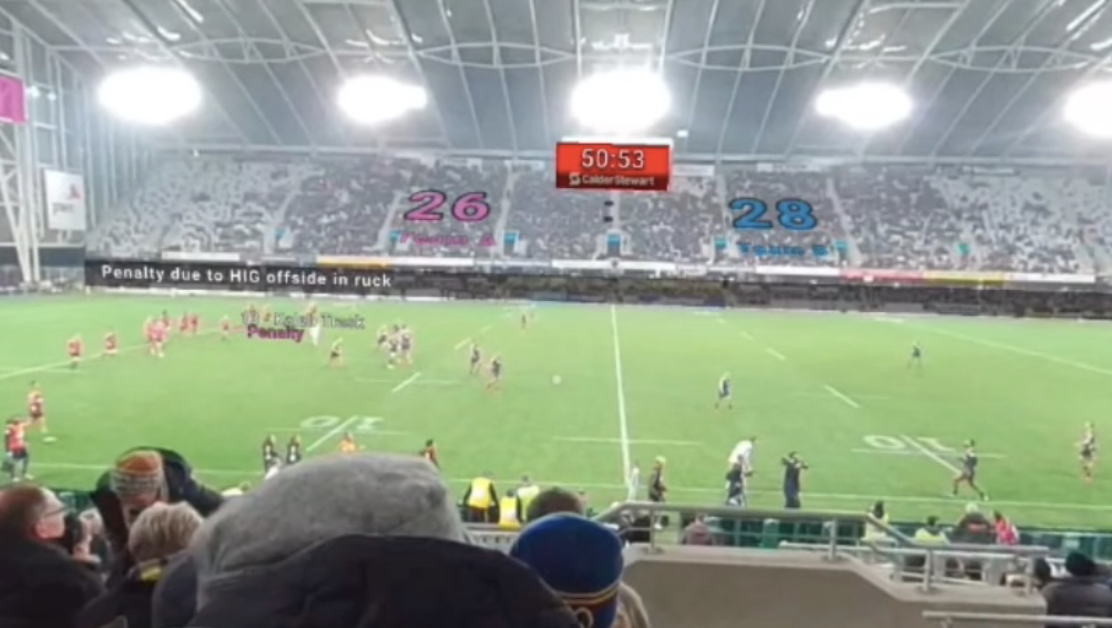
Augmented Reality for Supporting Accessible Sports Spectating and Training
Metaverse CHI2025 WorkshopAcceptedStefanie Zollmann, Ut Gong, Tobias Langlot
Sports events are widely enjoyed. However, following the game’s flow and recognizing key moments can pose challenges for attendees with varying accessibility needs. In this work, we explore using Augmented Reality (AR) to enhance accessibility and inclusivity at sports events and training sessions by providing real-time visual and contextual support to make sports experiences more engaging and comprehensible to those with vision and hearing impairments. Beyond addressing sports spectating, we also discuss how AR can achieve broader inclusivity by enabling dynamic, adaptable, and personalized visual support for sports training.

Augmented Reality for Supporting Accessible Sports Spectating and Training
Metaverse CHI2025 WorkshopAcceptedStefanie Zollmann, Ut Gong and Tobias Langlot
Sports events are widely enjoyed. However, following the game’s flow and recognizing key moments can pose challenges for attendees with varying accessibility needs. In this work, we explore using Augmented Reality (AR) to enhance accessibility and inclusivity at sports events and training sessions by providing real-time visual and contextual support to make sports experiences more engaging and comprehensible to those with vision and hearing impairments. Beyond addressing sports spectating, we also discuss how AR can achieve broader inclusivity by enabling dynamic, adaptable, and personalized visual support for sports training.
My Role: Conception, Paper Writing
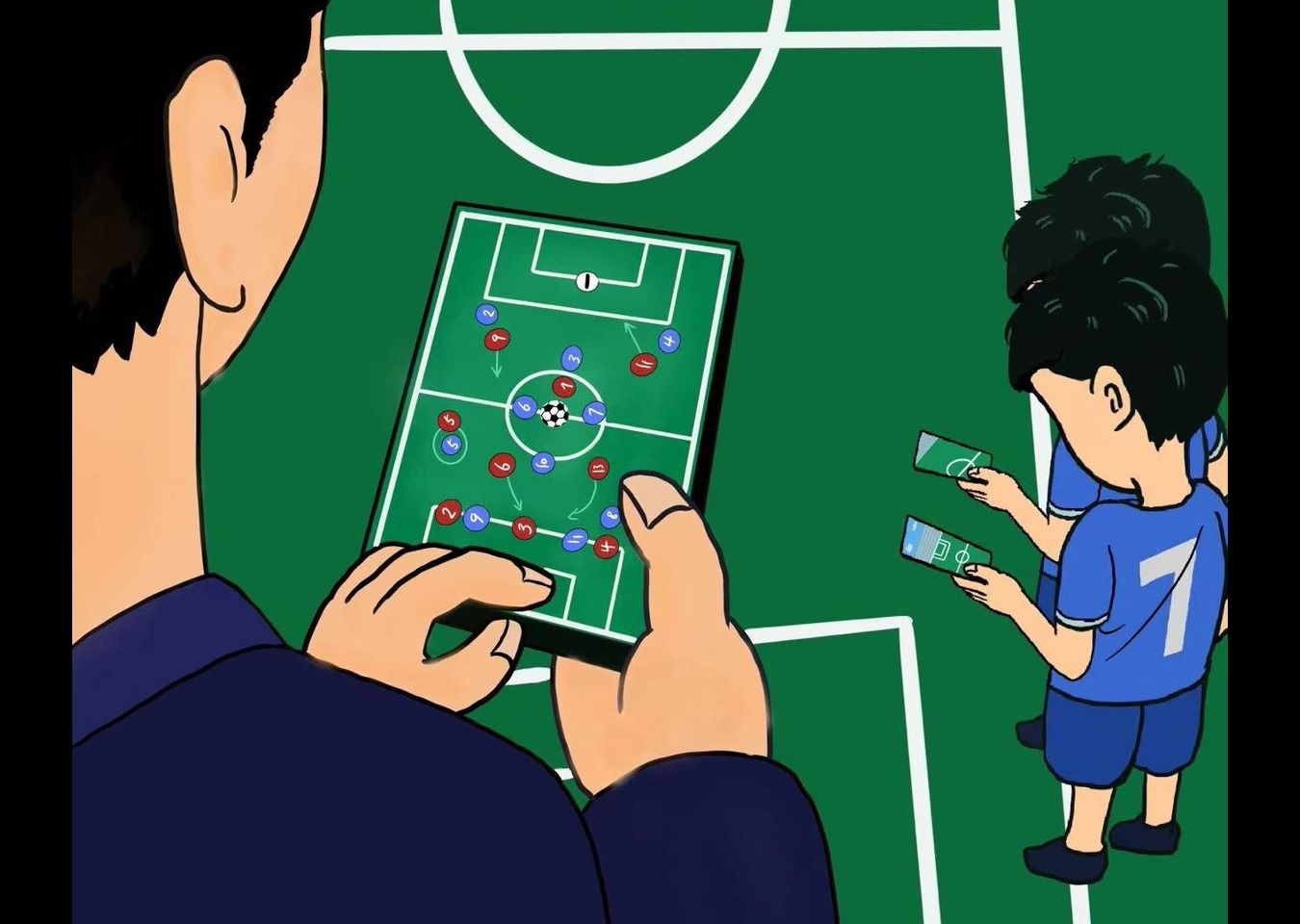
Collaborative XRTactics: A Formative Study on Tactical Communication in Outdoor Team Sports
IEEE VIS 2024 WorkshopAcceptedUt Gong, Qihan Zhang, Ziqing Yin, Stefanie Zollmann
In team sports, effective tactical communication is crucial for success, particularly in the fast-paced and complex environment of outdoor athletics. This paper investigates the challenges faced in transmitting strategic plans to players and explores potential solutions using eXtended Reality (XR) technologies. We conducted a formative study involving interviews with 4 Division I professional soccer coaches, 4 professional players, 2 college club coaches, and 2 college club players, as well as a survey among 17 Division I players. The study identified key requirements for tactical communication tools, including the need for rapid communication, minimal disruption to game flow, reduced cognitive load, clear visualization for all players, and enhanced auditory clarity. Based on these insights, we propose a potential solution - a Mobile Augmented Reality (AR) system designed to address these challenges by providing real-time, intuitive tactical visualization and communication. The system aims to improve strategic planning and execution, thereby enhancing team performance and cohesion. This work represents a significant step towards integrating XR technologies into sports coaching, offering a modern and practical solution for real-time tactical communication.

Collaborative XRTactics: A Formative Study on Tactical Communication in Outdoor Team Sports
IEEE VIS 2024 WorkshopAcceptedUt Gong, Qihan Zhang, Ziqing Yin, Stefanie Zollmann
In team sports, effective tactical communication is crucial for success, particularly in the fast-paced and complex environment of outdoor athletics. This paper investigates the challenges faced in transmitting strategic plans to players and explores potential solutions using eXtended Reality (XR) technologies. We conducted a formative study involving interviews with 4 Division I professional soccer coaches, 4 professional players, 2 college club coaches, and 2 college club players, as well as a survey among 17 Division I players. The study identified key requirements for tactical communication tools, including the need for rapid communication, minimal disruption to game flow, reduced cognitive load, clear visualization for all players, and enhanced auditory clarity. Based on these insights, we propose a potential solution - a Mobile Augmented Reality (AR) system designed to address these challenges by providing real-time, intuitive tactical visualization and communication. The system aims to improve strategic planning and execution, thereby enhancing team performance and cohesion. This work represents a significant step towards integrating XR technologies into sports coaching, offering a modern and practical solution for real-time tactical communication.
My Role: Conception, Formative Study, Implementation, Paper Writing
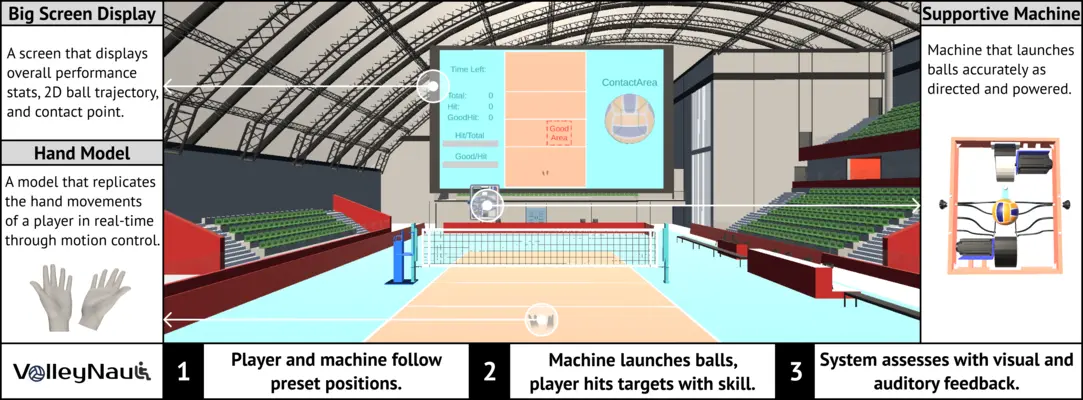
VolleyNaut: Pioneering Immersive Training for Inclusive Sitting Volleyball Skill Development
IEEE VR 2024AcceptedUt Gong, Hanze Jia, Yujie Wang, Tan Tang, Xiao Xie, Yingcai Wu
To address challenges in sitting volleyball training, we've created VolleyNaut—a VR system designed with input from professional coaches. It replicates daily drills and ball pitches, accommodating different skill levels for skill improvement. Our user study involving both pros and novices shows that VolleyNaut can enhance accessibility and engagement in sports training, particularly in communities with limited resources.

VolleyNaut: Pioneering Immersive Training for Inclusive Sitting Volleyball Skill Development
IEEE VR 2024AcceptedUt Gong, Hanze Jia, Yujie Wang, Tan Tang, Xiao Xie, Yingcai Wu
To address challenges in sitting volleyball training, we've created VolleyNaut—a VR system designed with input from professional coaches. It replicates daily drills and ball pitches, accommodating different skill levels for skill improvement. Our user study involving both pros and novices shows that VolleyNaut can enhance accessibility and engagement in sports training, particularly in communities with limited resources.
My Role: Conception, Formative Study, Implementation, Evaluation, Paper Writing
